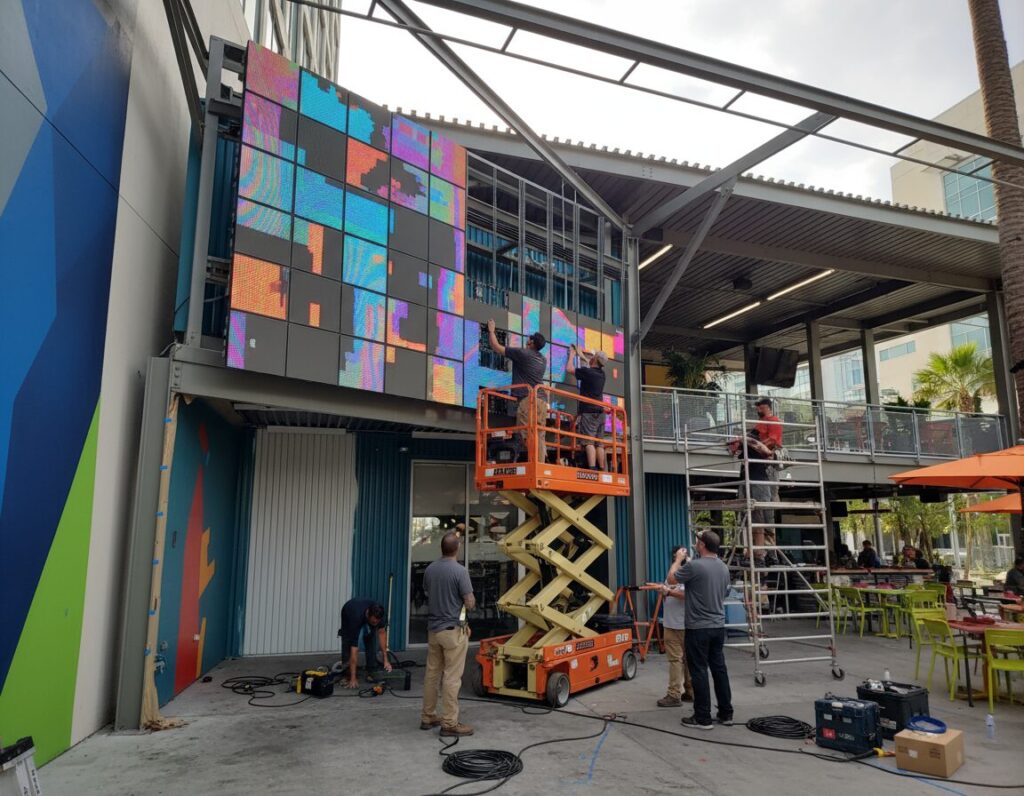The thought of managing complex technology can often bring up concerns about maintenance. For businesses investing in impressive visual and audio solutions like commercial video walls, a common question pops up: are these sophisticated systems difficult to maintain? The good news is, today’s commercial audiovisual integration prioritizes practicality and ease of upkeep, a significant shift from older, more cumbersome methods.
The Evolution of Video Wall Serviceability
Gone are the days when a malfunctioning video wall panel meant dismantling half the display from behind, often requiring specialized access and extensive downtime. Modern commercial video walls are designed with “front-service” access. This intelligent design allows technicians to perform repairs or replace modules directly from the front of the display.
This front-facing approach offers several critical advantages:
- Reduced Disruption: No need to clear an entire room or create large service pathways behind the display. Technicians work efficiently in the existing space.
- Faster Resolution: Issues are identified and fixed quicker, minimizing the time your impactful visual message is offline.
- Simplified Installation: While not directly maintenance, the design principles that enable front-service also often simplify the initial setup.
This focus on user-friendly maintenance extends beyond just the physical accessibility; it’s a core principle in how commercial AV technology is now developed and integrated.
More Than Just Displays: The Integrated AV Ecosystem
A commercial video wall rarely stands alone. It’s typically part of a larger, integrated AV ecosystem that includes commercial sound systems, control interfaces, content management tools, and networking infrastructure. The challenge used to be that each component might have its own separate maintenance requirements and diagnostics. However, modern integration strategies aim for a unified, holistic approach.
Today’s AV systems often feature:
- Centralized Control: One platform to manage and monitor various AV components.
- Networked Components: Devices communicate over standard IP networks, making remote diagnostics and software updates more feasible.
- Modular Design: Many components, from video processors to audio amplifiers, are designed for quick swapping, similar to the video wall panels.
This convergence simplifies troubleshooting and makes overall system health checks more efficient.
Smart Sound, Seamless Experience
Commercial sound systems have also seen significant advancements in serviceability. High-quality audio is crucial for everything from retail environments to corporate boardrooms and large venues. Modern sound systems, leveraging digital signal processing (DSP) and AV-over-IP technologies, are far more intelligent than their predecessors.
Key features contributing to easier sound system maintenance include:
- Remote Monitoring: Many systems can be monitored from off-site, allowing technicians to identify potential issues (like a failing amplifier channel or microphone feedback) before they become critical.
- Software-Defined Adjustments: Audio routing, equalization, and volume levels can often be adjusted or reconfigured through software, reducing the need for on-site physical adjustments.
- Networked Audio: Protocols like Dante or AVB simplify cabling and allow for easier expansion or re-configuration without complex rewiring.
These advancements mean that sound issues, which once might have required a full system audit, can often be diagnosed and resolved with targeted adjustments or component swaps.
The Role of Proactive Monitoring and Support
The biggest recent news in commercial AV isn’t just about the hardware; it’s about how these systems are supported throughout their lifecycle. Integrators now commonly offer proactive monitoring and managed service agreements. These services utilize cloud-based platforms and AI-assisted analytics to continuously check system health.
Consider the benefits of modern AV system management:
| Feature Category | Modern AV System Management | Benefits |
|---|---|---|
| Physical Access | Front-serviceability, quick-swap modules | Minimal disruption, faster repairs, reduced labor |
| Connectivity | IP-based networking (AV-over-IP) | Remote diagnostics, simplified cabling, easier upgrades |
| Monitoring & Control | Centralized platforms, cloud monitoring, AI-assisted analytics | Proactive issue detection, remote troubleshooting, predictive maintenance, reduced downtime |
| Updates & Security | Automated firmware/software updates, security patches | Enhanced performance, security, and longevity of investment |
This proactive approach means potential issues can be flagged and addressed before they impact your operations. Firmware updates, security patches, and performance optimizations can often be deployed remotely, keeping your AV investment robust and reliable.
In conclusion, the days of AV systems being a maintenance nightmare are largely behind us. Modern commercial audiovisual integration, from sophisticated video walls to robust sound systems, is built with longevity, ease of service, and operational efficiency in mind. This thoughtful design ensures that businesses can leverage cutting-edge technology without the constant worry of complex upkeep.
Frequently Asked Questions
Q1: What does “front-service access” mean for video walls?
A1: Front-service access allows technicians to perform maintenance, repairs, or module replacements on a video wall from the front of the display, rather than requiring access from behind. This significantly reduces downtime and disruption to the surrounding space.
Q2: How do modern commercial sound systems simplify maintenance?
A2: Modern commercial sound systems leverage technologies like networked audio (AV-over-IP) and digital signal processing (DSP), enabling remote monitoring, software-defined adjustments, and easier diagnostics. This often means issues can be identified and resolved without a full on-site inspection.
Q3: Is remote monitoring common for integrated AV systems?
A3: Yes, remote monitoring is a growing trend. Many commercial AV integrators offer managed service agreements that include cloud-based monitoring tools. These tools allow for proactive identification of potential system issues, performance optimization, and even remote troubleshooting, reducing the need for frequent on-site visits.
Q4: How often should a commercial AV system be serviced?
A4: The ideal service frequency depends on the system’s complexity, usage, and environment. However, many businesses benefit from annual or semi-annual preventative maintenance checks, along with continuous remote monitoring. Your AV integrator can recommend a tailored service schedule.

